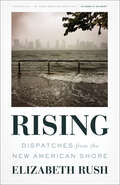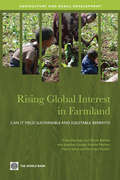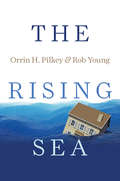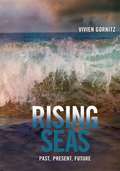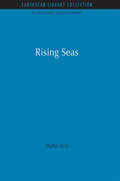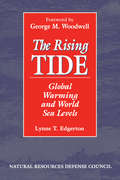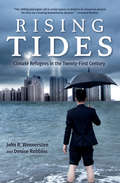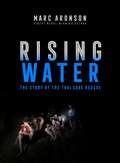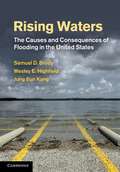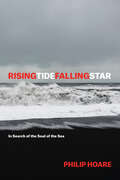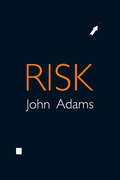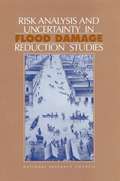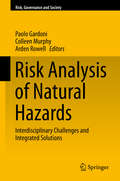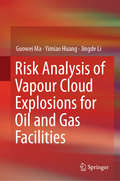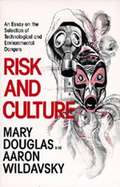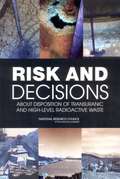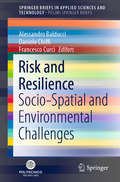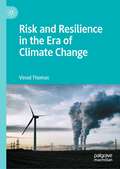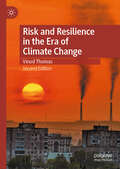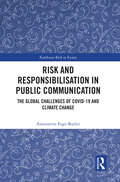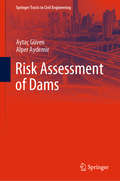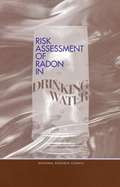- Table View
- List View
Rising: Dispatches from the New American Shore
by Elizabeth RushA Pulitzer Prize Finalist, this powerful elegy for our disappearing coast “captures nature with precise words that almost amount to poetry” (The New York Times).Hailed as “the book on climate change and sea levels that was missing” (Chicago Tribune), Rising is both a highly original work of lyric reportage and a haunting meditation on how to let go of the places we love.With every record-breaking hurricane, it grows clearer that climate change is neither imagined nor distant—and that rising seas are transforming the coastline of the United States in irrevocable ways. In Rising, Elizabeth Rush guides readers through these dramatic changes, from the Gulf Coast to Miami, and from New York City to the Bay Area. For many of the plants, animals, and humans in these places, the options are stark: retreat or perish.Rush sheds light on the unfolding crises through firsthand testimonials—a Staten Islander who lost her father during Sandy, the remaining holdouts of a Native American community on a drowning Isle de Jean Charles, a neighborhood in Pensacola settled by escaped slaves hundreds of years ago—woven together with profiles of wildlife biologists, activists, and other members of these vulnerable communities.A Guardian, Publishers Weekly, and Library Journal Best Book Of 2018Winner of the National Outdoor Book AwardA Chicago Tribune Top Ten Book of 2018
Rising Global Interest in Farmland: Can It Yield Sustainable and Equitable Benefits?
by Jonathan Lindsay Harris Selod Derek Byerlee Mercedes Stickler Klaus Deininger Andrew NortonThis book aims to provide key pieces of information needed for informed debate about large-scale land acquisition by drawing on the experience from past land expansions, discussing predictions for potential future demand, and providing empirical evidence of what is happening on the ground in the countries most affected by the recent increase in demand for land. It complements demand side considerations with a detailed assessment of the amount of land, whether currently cultivated or not, that might potentially be available for agricultural cultivation at the global and country levels. It then describes in some detail the policies in place to manage land acquisition processes and analyzes how these policies may affect outcomes. This information can help governments in land abundant countries to assess how best to integrate increased demand for land into their rural development strategies and provide opportunities and benefits to all involved, including existing smallholders. This is particularly important as many of these countries also have high yield gaps. It also highlights how, in cases where land acquisition by large investors makes sense from a social, economic, and environmental perspective, governments can create an environment that can help to attract outside investment that contributes to broad-based growth and poverty reduction.
The Rising Sea
by Orrin H. Pilkey Rob YoungOn Shishmaref Island in Alaska, homes are being washed into the sea. In the South Pacific, small island nations face annihilation by encroaching waters. In coastal Louisiana, an area the size of a football field disappears every day. For these communities, sea level rise isn't a distant, abstract fear: it's happening now and it's threatening their way of life. In The Rising Sea, Orrin H. Pilkey and Rob Young warn that many other coastal areas may be close behind. Prominent scientists predict that the oceans may rise by as much as seven feet in the next hundred years. That means coastal cities will be forced to construct dikes and seawalls or to move buildings, roads, pipelines, and railroads to avert inundation and destruction. The question is no longer whether climate change is causing the oceans to swell, but by how much and how quickly. Pilkey and Young deftly guide readers through the science, explaining the facts and debunking the claims of industry-sponsored "skeptics." They also explore the consequences for fish, wildlife--and people. While rising seas are now inevitable, we are far from helpless. By making hard choices--including uprooting citizens, changing where and how we build, and developing a coordinated national response--we can save property, and ultimately lives. With unassailable research and practical insights, The Rising Sea is a critical first step in understanding the threat and keeping our heads above water.
Rising Seas: Past, Present, Future
by Vivien GornitzThe Earth's climate is already warming due to increased concentrations of human-produced greenhouse gases in the atmosphere, and the specter of rising sea level is one of global warming's most far-reaching threats. Sea level will keep rising long after greenhouse gas emissions have ceased, because of the delay in penetration of surface warming to the ocean depths and because of the slow dissipation of excess atmospheric carbon dioxide. Adopting a long perspective that interprets sea level changes both underway and expected in the near future, Vivien Gornitz completes a highly relevant and necessary study of an unprecedented age in Earth's history.Gornitz consults past climate archives to help better anticipate future developments and prepare for them more effectively. She focuses on several understudied historical events, including the Paleocene-Eocene Thermal Anomaly, the Messinian salinity crisis, the rapid filling of the Black Sea (which may have inspired the story of Noah's flood), and the Storrega submarine slide, an incident possibly connected to a sea level occurrence roughly 8,000 years old. By examining dramatic variations in past sea level and climate, Gornitz concretizes the potential consequences of rapid, human-induced warming. She builds historical precedent for coastal hazards associated with a higher ocean level, such as increased damage from storm surge flooding, even if storm characteristics remain unchanged. Citing the examples of Rotterdam, London, New York City, and other forward-looking urban centers that are effectively preparing for higher sea level, Gornitz also delineates the difficult economic and political choices of curbing carbon emissions while underscoring, through past geological analysis, the urgent need to do so.
Rising Seas: Past, Present, Future
by Vivien GornitzThe Earth's climate is already warming due to increased concentrations of human-produced greenhouse gases in the atmosphere, and the specter of rising sea level is one of global warming's most far-reaching threats. Sea level will keep rising long after greenhouse gas emissions have ceased, because of the delay in penetration of surface warming to the ocean depths and because of the slow dissipation of excess atmospheric carbon dioxide. Adopting a long perspective that interprets sea level changes both underway and expected in the near future, Vivien Gornitz completes a highly relevant and necessary study of an unprecedented age in Earth's history. Gornitz consults past climate archives to help better anticipate future developments and prepare for them more effectively. She focuses on several understudied historical events, including the Paleocene-Eocene Thermal Anomaly, the Messinian salinity crisis, the rapid filling of the Black Sea (which may have inspired the story of Noah's flood), and the Storrega submarine slide, an incident possibly connected to a sea level occurrence roughly 8,000 years old. By examining dramatic variations in past sea level and climate, Gornitz concretizes the potential consequences of rapid, human-induced warming. She builds historical precedent for coastal hazards associated with a higher ocean level, such as increased damage from storm surge flooding, even if storm characteristics remain unchanged. Citing the examples of Rotterdam, London, New York City, and other forward-looking urban centers that are effectively preparing for higher sea level, Gornitz also delineates the difficult economic and political choices of curbing carbon emissions while underscoring, through past geological analysis, the urgent need to do so.
Rising Seas: Rising Seas (Sustainable Development Set)
by Martin InceRecent and dramatic flooding in places as far apart as Bangladesh and North Wales are example of what could become commonplace if sea levels rise. Most scientists are predicting a rise of about one metre and this book, based on research carried out for the Commonwealth governments, describes in simple terms what in. likely to happen as a result and where the worst effects will be. Martin Ince, a well-known scientific journalist, deals with the accuracy of our knowledge and the possible errors in assessment. He considers the different kinds of damage that higher seas could cause, inundation, increased salination, coral damage, increased flood and surge damage and so on. Brief case studies are included covering the UK, the Maldives, North America, Bangladesh, Guyana, Kiribati, The Netherlands, Italy, Egypt and Australasia. The book ends with an examination of the scientific and technical developments which could make the problems easier to deal with and, above all, set. out the policies on which governments must agree. Originally published in 1990
The Rising Tide: Global Warming And World Sea Levels
by Lynne EdgertonThe Rising Tide is the first analysis of global warming and world sea level rise. It outlines state, national, and international actions to respond to the effects of global warming on coastal communities and ecosystems.
Rising Tides: Climate Refugees in the Twenty-First Century (Encounters: Explorations in Folklore and Ethnomusicology)
by John R. Wennersten and Denise Robbins&“Deals masterfully with a neglected crisis, how climate change is driving migration . . . The work broaches solutions both practical . . . and political.&”—Christopher E. Goldthwait, former US Ambassador With global climate change upon us, it is imperative to start thinking about the massive numbers of people who will be displaced by environmental crises. The rise in sea levels alone will account for hundreds of millions of refugees around the globe. In Rising Tides, John R. Wennersten and Denise Robbins face the difficult questions that will have to be answered: How will people be relocated and settled? Is it possible to offer environmental refugees temporary or permanent asylum? Will these refugees have any collective rights in the new areas they inhabit? And lastly, who will pay the costs of all the affected countries during the process of resettlement? Offering an essential, continent-by-continent look at these dangers, Rising Tides is &“a passionately argued, well-documented wake-up call on the dire, current and undeniable human fallout from climate change. Looking behind the headlines, it connects the dots in a way that will inform and should alarm us all&” (Eugene L. Meyer, author of Five for Freedom). &“This chilling and urgent call to action spares no detail in its mission to present the facts on a looming humanitarian disaster. Climate-change warning messages too often focus on the environment without going into specifics of how humans will be hurt by global warming. Rising Tides singlehandedly rectifies this issue.&”—Foreword Reviews &“A must read for policymakers and those in positions of power, especially the ones who remain in a state of denial about climate change and refuse to do enough to address the crisis.&”—The Hindu
Rising Water: The Story of the Thai Cave Rescue
by Marc AronsonThe incredible true story of the twelve boys trapped with their coach in a flooded cave in Thailand and their inspiring rescue—as seen in Ron Howard's Thirteen Lives.On June 23, 2018, twelve members of the Wild Boars soccer team and their coach were exploring the Tham Luang cave complex in northern Thailand when disaster struck. A rainy season downpour flooded the tunnels, trapping them as they took shelter on a shelf of the dark cave. Eight days of searching yielded no signs of life, but on July 2 they were discovered by two British divers. The boys and their coach were eventually rescued in an international operation that took three days. What could have been a terrible tragedy became an amazing story of survival. Award-winning author Marc Aronson brings us the backstory behind how this astounding rescue took place. Rising Water highlights the creative thinking and technology that made a successful mission possible by examining the physical, environmental, and psychological factors surrounding the rescue. From the brave Thai Navy SEAL who lost his life while placing oxygen tanks along the passageways of the cave, to the British divers that ultimately swam the boys to safety, to the bravery of the boys and their coach, this is the breathtaking rescue that captivated the entire world.
Rising Waters
by Samuel D. Brody Jung Eun Kang Wesley E. HighfieldIn the wake of Hurricane Katrina and the flooding of New Orleans in 2005, this interdisciplinary book brings together five years of empirical research funded by the National Science Foundation. It explores the causes of flooding in the United States and the ways in which local communities can reduce the associated human casualties and property damage. Focussing on Texas and Florida, the authors investigate factors other than rainfall that determine the degree of flooding, and consider the key role of non-structural techniques and strategies in flood mitigation. The authors present an empirical and multi-scale assessment that underlines the critical importance of local planning and development decisions. Written for advanced students and researchers in hazard mitigation, hydrology, geography, environmental planning and public policy, this book will also provide policy makers, government employees and engineers with important insights into how to make their communities more resilient to the adverse impacts of flooding.
RISINGTIDEFALLINGSTAR: In Search of the Soul of the Sea
by Philip Hoare“Every day is an anxiety in my ways of getting to the water. . . . I’ve become so attuned to it, so scared of it, so in love with it that sometimes I can only think by the sea. It is the only place I feel at home.” Many of us visit the sea. Admire it. Even profess to love it. But very few of us live it. Philip Hoare does. He swims in the sea every day, either off the coast of his native Southampton or his adopted Cape Cod. He watches its daily and seasonal changes. He collects and communes with the wrack—both dead and never living—that it throws up on the shingle. He thinks with, at, through the sea. All of which should prepare readers: RISINGTIDEFALLINGSTAR is no ordinary book. It mounts no straight-ahead argument. It hews to no single genre. Instead, like the sea itself, it moves, flows, absorbs, transforms. In its pages we find passages of beautiful nature and travel writing, lyrical memoir, seams of American and English history and much more. We find Thoreau and Melville, Bowie and Byron, John Waters and Virginia Woolf, all linked through a certain refusal to be contained, to be strictly defined—an openness to discovery and change. Running throughout is an air of elegy, a reminder that the sea is an ending, a repository of lost ships, lost people, lost ways of being. It is where we came from; for Hoare, it is where he is going. “Every swim is a little death,” Hoare writes, “but it is also a reminder that you are alive.” Few books have ever made that knife’s edge so palpable. Read RISINGTIDEFALLINGSTAR. Let it settle into the seabed of your soul. You’ll never forget it.
Risk: Living With Perils In The 21st Century (Advances In Natural And Technological Hazards Research Ser. #33)
by John AdamsRisk compensation postulates that everyone has a "risk thermostat" and that safety measures that do not affect the setting of the thermostat will be circumvented by behaviour that re-establishes the level of risk with which people were originally comfortable. It explains why, for example, motorists drive faster after a bend in the road is straightened. Cultural theory explains risk-taking behaviour by the operation of cultural filters. It postulates that behaviour is governed by the probable costs and benefits of alternative courses of action which are perceived through filters formed from all the previous incidents and associations in the risk-taker's life.; "Risk" should be of interest to many readers throughout the social sciences and in the world of industry, business, engineering, finance and public administration, since it deals with a fundamental part of human behaviour that has enormous financial and economic implications.
Risk Analysis And Uncertainty In Flood Damage Reduction Studies
by Committee on Risk-Based Analysis for Flood Damage ReductionReducing flood damage is a complex task that requires multidisciplinary understanding of the earth sciences and civil engineering. In addressing this task the U.S. Army Corps of Engineers employs its expertise in hydrology, hydraulics, and geotechnical and structural engineering. Dams, levees, and other river-training works must be sized to local conditions; geotechnical theories and applications help ensure that structures will safely withstand potential hydraulic and seismic forces; and economic considerations must be balanced to ensure that reductions in flood damages are proportionate with project costs and associated impacts on social, economic, and environmental values.A new National Research Council report, Risk Analysis and Uncertainty in Flood Damage Reduction Studies, reviews the Corps of Engineers' risk-based techniques in its flood damage reduction studies and makes recommendations for improving these techniques. Areas in which the Corps has made good progress are noted, and several steps that could improve the Corps' risk-based techniques in engineering and economics applications for flood damage reduction are identified. The report also includes recommendations for improving the federal levee certification program, for broadening the scope of flood damage reduction planning, and for improving communication of risk-based concepts.
Risk Analysis of Natural Hazards
by Paolo Gardoni Colleen Murphy Arden RowellThis volume investigates the interdisciplinary and cross-cutting challenges in the risk analysis of natural hazards. It brings together leading minds in engineering, science, philosophy, law, and the social sciences. Parts I and II of this volume explore risk assessment, first by providing an overview of the interdisciplinary interactions involved in the assessment of natural hazards, and then by exploring the particular impacts of climate change on natural hazard assessment. Part III discusses the theoretical frameworks for the evaluation of natural hazards. Finally, Parts IV and V address the risk management of natural hazards, providing first an overview of the interdisciplinary interactions underlying natural hazard management, and then exploring decision frameworks that can help decision makers integrate and respond to the complex relationships among natural events, the built environment, and human behavior.
Risk Analysis of Vapour Cloud Explosions for Oil and Gas Facilities
by Guowei Ma Yimiao Huang Jingde LiThis book focuses on describing and applying risk analysis of vapour cloud explosions (VCEs) in various oil and gas facilities, such as petrol stations, processing plants, and offshore platforms. Discussing most of the complicated features of gas explosion accidents, the book studies in detail the gas explosion risk analysis approaches of different oil and gas facilities in order to develop more accurate, detailed, efficient and reliable risk analysis methods for VCEs under different conditions. Moreover, it introduces an advanced overpressure approach to predict VCEs using computational fluid dynamics (CFD) modelling, and details applications of CFD using a FLame ACceleration Simulator (FLACS). The book is intended for researchers and organisations engaged in risk and safety assessments of VCEs in the oil and gas industry.
Risk and Culture: An Essay on the Selection of Technological and Environmental Dangers
by Mary Douglas Aaron B. WildavskyThis research-based book speaks about risks of lapses on environmental conservation and protection endangering the life and security of Americans and the imperative need to wake up and address the issues.
Risk And Decisions: About Disposition Of Transuranic And High-level Radioactive Waste
by Committee on Risk-Based Approaches for Disposition of Transuranic High-Level Radioactive WasteThe U.S. Department of Energy (DOE) manages dozens of sites across the nation that focus on research, design, and production of nuclear weapons and nuclear reactors for defense applications. Radioactive wastes at these sites pose a national challenge, and DOE is considering how to most effectively clean them up. Some of the greatest projected risks, cleanup costs, and technical challenges come from processing and disposing transuranic and high-level radioactive waste. This report addresses how DOE should incorporate risk into decisions about whether the nation should use alternatives to deep geologic disposal for some of these wastes. It recommends using an exemption process involving risk assessment for determining how to dispose of problematic wastes. The report outlines criteria for risk assessment and key elements of a risk-informed approach. The report also describes the types of wastes that are candidates for alternative disposition paths, potential alternatives to deep geologic disposal for disposition of low-hazard waste, and whether these alternatives are compatible with current regulations.
Risk and Resilience: Socio-Spatial and Environmental Challenges (SpringerBriefs in Applied Sciences and Technology)
by Alessandro Balducci Daniele Chiffi Francesco CurciThis book presents and discusses methodological approaches and operational tools aimed at increasing the awareness and skills necessary to face the social, economic and environmental challenges usually encountered in spatial planning. In addition, it deals with the concepts of risk and resilience from both a theoretical and operational point of view. The book promotes a better understanding of risk, resilience, and related notions such as vulnerability, fragility and anti-fragility in urban and landscape studies, while also analyzing new planning policies. Accordingly, it will benefit all researchers and public decision-makers looking for an interdisciplinary approach to risk and resilience.
Risk and Resilience in the Era of Climate Change
by Vinod ThomasThis book presents essential insights on the interaction between rising risks and raising the bar for resilience during the climate crisis. Its timeliness lies in applying important findings on risk and resilience to runaway climate change. When risk and resilience are brought together in the context of climate catastrophes, three key messages emerge.The first is that accounting for the root causes of these calamities, and not just their symptoms, is essential to slowing the spike in these events. It is therefore vital to link carbon emissions from human activity to the sharp rise in climate disasters globally. The second is that growth economics and policy must factor in the failure of governments and businesses to tackle spillover harm from economic activities, as seen dramatically with global warming. With climate risks rising, this calls for a fundamental revision in the teaching and practice of business and economics. And third, prevention must become a far bigger part of resilience building, with greater preparedness for more intense destruction built into interventions. This emphasis on prevention deems disaster recovery as not just returning to how things were but building back better.
Risk and Resilience in the Era of Climate Change
by Vinod ThomasThis book presents essential insights on the interaction between rising risks and raising the bar for resilience during the climate crisis. Its timeliness lies in applying important findings on risk and resilience to runaway climate change. When risk and resilience are brought together in the context of climate catastrophes, three key messages emerge. The first is that accounting for the root causes, and not just their symptoms, is essential to slowing these events. It is therefore vital to link carbon emissions from human activity to the sharp rise in climate disasters globally. The second is that growth economics and policy must factor in the failure of governments and businesses to tackle spillover harm from economic activities, as seen strikingly with global warming AND BIODIVERSITY LOSS. With climate risks rising, this calls for a fundamental revision of the framing of growth in the teaching and practice of business and economics. And third, prevention must become a far bigger part of resilience building, with preparedness to avert or handle tougher eventualities built into interventions. Emphasis on prevention deems disaster recovery as not just returning to how things were but building back better.
Risk and Responsibilisation in Public Communication: The Global Challenges of COVID-19 and Climate Change (Earthscan Risk in Society)
by Antoinette Fage-ButlerThis book explores the connections between risk and responsibilisation in official communication to the public about the global risks of the pandemic and climate change. Our media spheres in the 2020s have been saturated with information about what we should or should not be doing to meet the challenges of the COVID-19 pandemic and climate change. Although the ability of risk communication to ‘responsibilise’ the public is central to its functioning in our societies, this aspect has so far been under-investigated in academia. To address this lacuna, Antoinette Fage-Butler develops a discursive approach to risk communication that focuses on the values that are communicated in risk messages. Examples of official risk communication about the pandemic and climate change from national and transnational contexts are analysed and compared, leading to new empirical findings and theoretical insights about the nature of risk and responsibilisation. Fage-Butler also builds on recent stirrings in the evolving field of risk communication that highlight the importance of cultural and value-related factors. Overall, this book will equip researchers with an approach to risk communication that reflects the complexity of today’s global risk challenges. Risk and Responsibilisation in Public Communication will be of great interest to students and scholars of risk communication, public health and environmental studies.
Risk and Uncertainty Assessment for Natural Hazards
by Jonathan Rougier Steve Sparks Lisa J. HillAssessment of risk and uncertainty is crucial for natural hazard risk management, facilitating risk communication and informing strategies to successfully mitigate our society's vulnerability to natural disasters. Written by some of the world's leading experts, this book provides a state-of-the-art overview of risk and uncertainty assessment in natural hazards. It presents the core statistical concepts using clearly defined terminology applicable across all types of natural hazards and addresses the full range of sources of uncertainty, the role of expert judgement and the practice of uncertainty elicitation. The core of the book provides detailed coverage of all the main hazard types and concluding chapters address the wider societal context of risk management. This is an invaluable compendium for academic researchers and professionals working in the fields of natural hazards science, risk assessment and management and environmental science and will be of interest to anyone involved in natural hazards policy.
Risk Assessment and Indoor Air Quality (Indoor Air Research)
by Elizabeth L. AndersonWith the recent tightening of air quality standards as mandated by the U.S. EPA, has come great pressure on regulatory bodies at all levels of government, along with the industries and groups affected by these standards, to better assess the hazards and risks that result from air pollutants. Risk Assessment and Indoor Air Quality carefully ties tog
Risk Assessment of Dams (Springer Tracts in Civil Engineering)
by Aytaç Güven Alper AydemirThis book offers a timely report on methods for risk assessment procedures for dams, with a special emphasis on dams with small storage dimensions. It starts by introducing all important definitions relating to dams, dam safety, such as the most common failure modes, and risks. In turn, it describes in detail the most important evaluation procedures for various failure modes such as piping, flood, earthquake and stability are described in this chapter. Consequence assessment procedures, together with the different steps of the risk evaluation process, are analyzed, providing a guide on how to identify the appropriate failure mode for the examined dam and setting up the appropriate safety plan. The book introduces the most common methods for predicting peak breach discharge, analyzing some relevant case studies. Upon comparing the findings obtained with the different methods, the book concludes with some general suggestions and ideas for future developments. This book fills an important gap between theoretical works and real-life problems being investigating in practical research studies on dam safety and risk management. It provides readers with the necessary knowledge on risk analysis and shows how to apply this in practice to carry out dam safety studies. It offers practical guidelines to set up risk assessment procedures for different failure modes and predicting failure parameters such as failure time, peak breach discharge and breach width.
Risk Assessment of Radon in Drinking Water
by National Research CouncilThe Safe Drinking Water Act directs the U.S. Environmental Protection Agency (EPA) to regulate the quality of drinking water, including its concentration of radon, an acknowledged carcinogen.This book presents a valuable synthesis of information about the total inhalation and ingestion risks posed by radon in public drinking water, including comprehensive reviews of data on the transfer of radon from water to indoor air and on outdoor levels of radon in the United States. It also presents a new analysis of a biokinetic model developed to determine the risks posed by ingestion of radon and reviews inhalation risks and the carcinogenesis process. The volume includes scenarios for quantifying the reduction in health risk that might be achieved by a program to reduce public exposure to radon.Risk Assessment of Radon in Drinking Water, reflecting research and analysis mandated by 1996 amendments to the Safe Drinking Water Act, provides comment on a variety of methods to reduce radon entry into homes and to reduce the concentrations of radon in indoor air and in water. The models, analysis, and reviews of literature contained in this book are intended to provide information that EPA will need to set a new maximum contaminant level, as it is required to do in 2000.
